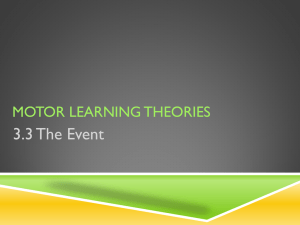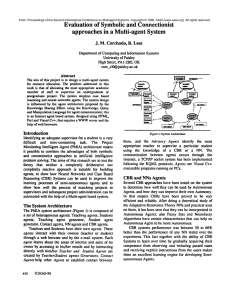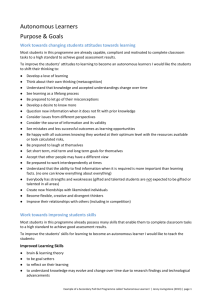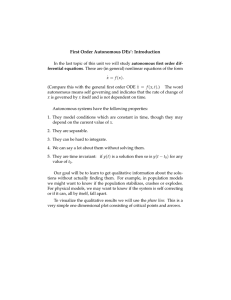Using Autonomous Agent-Based Systems to Counter Asymmetric Threats from Non-State Sponsored
advertisement
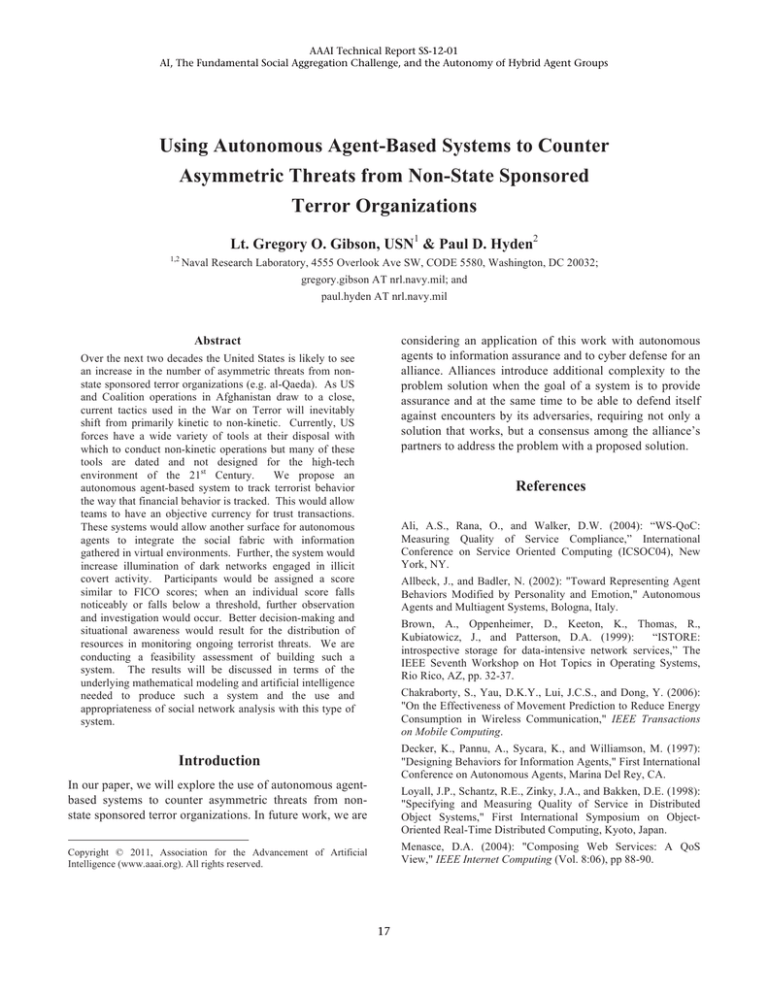
AAAI Technical Report SS-12-01 AI, The Fundamental Social Aggregation Challenge, and the Autonomy of Hybrid Agent Groups Using Autonomous Agent-Based Systems to Counter Asymmetric Threats from Non-State Sponsored Terror Organizations Lt. Gregory O. Gibson, USN1 & Paul D. Hyden2 1,2 Naval Research Laboratory, 4555 Overlook Ave SW, CODE 5580, Washington, DC 20032; gregory.gibson AT nrl.navy.mil; and paul.hyden AT nrl.navy.mil Abstract considering an application of this work with autonomous agents to information assurance and to cyber defense for an alliance. Alliances introduce additional complexity to the problem solution when the goal of a system is to provide assurance and at the same time to be able to defend itself against encounters by its adversaries, requiring not only a solution that works, but a consensus among the alliance’s partners to address the problem with a proposed solution. Over the next two decades the United States is likely to see an increase in the number of asymmetric threats from nonstate sponsored terror organizations (e.g. al-Qaeda). As US and Coalition operations in Afghanistan draw to a close, current tactics used in the War on Terror will inevitably shift from primarily kinetic to non-kinetic. Currently, US forces have a wide variety of tools at their disposal with which to conduct non-kinetic operations but many of these tools are dated and not designed for the high-tech environment of the 21st Century. We propose an autonomous agent-based system to track terrorist behavior the way that financial behavior is tracked. This would allow teams to have an objective currency for trust transactions. These systems would allow another surface for autonomous agents to integrate the social fabric with information gathered in virtual environments. Further, the system would increase illumination of dark networks engaged in illicit covert activity. Participants would be assigned a score similar to FICO scores; when an individual score falls noticeably or falls below a threshold, further observation and investigation would occur. Better decision-making and situational awareness would result for the distribution of resources in monitoring ongoing terrorist threats. We are conducting a feasibility assessment of building such a system. The results will be discussed in terms of the underlying mathematical modeling and artificial intelligence needed to produce such a system and the use and appropriateness of social network analysis with this type of system. References Ali, A.S., Rana, O., and Walker, D.W. (2004): “WS-QoC: Measuring Quality of Service Compliance,” International Conference on Service Oriented Computing (ICSOC04), New York, NY. Allbeck, J., and Badler, N. (2002): "Toward Representing Agent Behaviors Modified by Personality and Emotion," Autonomous Agents and Multiagent Systems, Bologna, Italy. Brown, A., Oppenheimer, D., Keeton, K., Thomas, R., Kubiatowicz, J., and Patterson, D.A. (1999): “ISTORE: introspective storage for data-intensive network services,” The IEEE Seventh Workshop on Hot Topics in Operating Systems, Rio Rico, AZ, pp. 32-37. Chakraborty, S., Yau, D.K.Y., Lui, J.C.S., and Dong, Y. (2006): "On the Effectiveness of Movement Prediction to Reduce Energy Consumption in Wireless Communication," IEEE Transactions on Mobile Computing. Decker, K., Pannu, A., Sycara, K., and Williamson, M. (1997): "Designing Behaviors for Information Agents," First International Conference on Autonomous Agents, Marina Del Rey, CA. Introduction In our paper, we will explore the use of autonomous agentbased systems to counter asymmetric threats from nonstate sponsored terror organizations. In future work, we are Loyall, J.P., Schantz, R.E., Zinky, J.A., and Bakken, D.E. (1998): "Specifying and Measuring Quality of Service in Distributed Object Systems," First International Symposium on ObjectOriented Real-Time Distributed Computing, Kyoto, Japan. Menasce, D.A. (2004): "Composing Web Services: A QoS View," IEEE Internet Computing (Vol. 8:06), pp 88-90. Copyright © 2011, Association for the Advancement of Artificial Intelligence (www.aaai.org). All rights reserved. 17 Peer, J. (2005): "Web Service Composition as AI Planning - a Survey," University of St. Gallen. Pistore, M., Barbon, F., Bertoli, P., Shaparau, D., and Traverso, (2004): P. Planning and Monitoring Web Rahmati, A., and Zhong, L. (2007): "Context-for-wireless: context-sensitive energy-efficient wireless data transfer," 5th International Conference on Mobile systems, Applications and Services San Juan, Puerto Rico. Roughan, M., Griffin, T., Mao, M., Greenberg, A., and Freeman, B. (2004): "Combining routing and traffic data for detection of IP forwarding anomalies," ACM SIGMETRICS Performance Evaluation Review. Russell, S., Hyden, P. & Lawless, W.F. (2011, October): “Enterprise Decision-Making: Consensus Versus Majority Rule Decisions”, 3rd Annual Complexity in Business Conference, U. Maryland. Shahram, G., Shyam, K., and Bhaskar, K. (2006): "An evaluation of availability latency in carrier-based wehicular ad-hoc networks," in: Proceedings of the 5th ACM international workshop on Data engineering for wireless and mobile access, ACM Press, Chicago, Illinois. Thio, N., and Karunasekera, S. (2005): "Automatic measurement of a QoS metric for Web service recommendation," 2005 Australian Software Engineering Conference, Brisbane, Australia. Weatherspoon, H., Chun, B.-G., So, C.W., and Kubiatowicz, J. (2005): "Long-Term Data Maintenance in Wide-Area Storage Systems: A Quantitative Approach," University of California, Berkely, Electrical Engineering & Computer Sciences Department, Berkely, CA. 18
